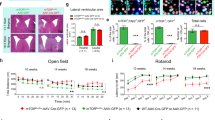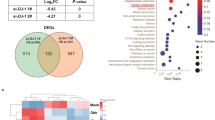Abstract
L-DOPA–induced dyskinesia, the rate-limiting side effect in the therapy of Parkinson's disease, is mediated by activation of mammalian target of rapamycin (mTOR) signaling in the striatum. We found that Ras homolog enriched in striatum (Rhes), a striatal-specific protein, binds to and activates mTOR. Moreover, Rhes−/− mice showed reduced striatal mTOR signaling and diminished dyskinesia, but maintained motor improvement on L-DOPA treatment, suggesting a therapeutic benefit for Rhes-binding drugs.
This is a preview of subscription content, access via your institution
Access options
Subscribe to this journal
Receive 12 print issues and online access
$209.00 per year
only $17.42 per issue
Buy this article
- Purchase on Springer Link
- Instant access to full article PDF
Prices may be subject to local taxes which are calculated during checkout


Similar content being viewed by others
References
Santini, E., Heiman, M., Greengard, P., Valjent, E. & Fisone, G. Sci. Signal. 2, 36 (2009).
Subramaniam, S., Sixt, M.K., Barrow, R. & Snyder, S.H. Science 324, 1327–1330 (2009).
Seredenina, T., Gokce, O. & Luthi-Carter, R. PLoS ONE 6, e22231 (2011).
Subramaniam, S. et al. J. Biol. Chem. 285, 20428–20432 (2010).
Long, X., Lin, Y., Ortiz-Vega, S., Yonezawa, K. & Avruch, J. Curr. Biol. 15, 702–713 (2005).
Vargiu, P. et al. Oncogene 23, 559–568 (2004).
Errico, F. et al. Mol. Cell. Neurosci. 37, 335–345 (2008).
Santini, E. et al. J. Neurosci. 27, 6995–7005 (2007).
Quintero, G.C., Spano, D., Lahoste, G.J. & Harrison, L.M. Neuroreport 19, 1563–1566 (2008).
Sancak, Y. et al. Science 320, 1496–1501 (2008).
Malagelada, C., Jin, Z.H., Jackson-Lewis, V., Przedborski, S. & Greene, L.A. J. Neurosci. 30, 1166–1175 (2010).
Acknowledgements
We thank R. Romano, D. Vitucci, V. Marsili, P. Scherer and S. Korde for valuable technical assistance, and R. DiLauro (University of Naples) for providing the Rhes−/− mice. This work was supported by United States Public Health Service grant MH18501 (S.H.S.) and a grant of the Cure for Huntington's Disease Initiative (S.H.S.).
Author information
Authors and Affiliations
Contributions
S.S. initiated the project and conducted the mTOR binding and activation experiments, which were further characterized by R.G.M. A.U. initiated the dyskinesia and mTOR experiments in mice. S.S. and S.H.S. further conceived and designed the experiments. F.N. and F.E. conducted the L-DOPA and behavioral experiments, under the direction of A.U. R.B. generated the Rhes constructs. S.K. performed the in vitro mTOR activity assay. R.T. and N.S. contributed to the mTOR activity and binding experiments. S.H.S. wrote the manuscript with input from R.G.M., S.S. and A.U.
Corresponding author
Ethics declarations
Competing interests
The authors declare no competing financial interests.
Supplementary information
Supplementary Text and Figures
Supplementary Text and Supplementary Figures 1–10 (PDF 1320 kb)
Rights and permissions
About this article
Cite this article
Subramaniam, S., Napolitano, F., Mealer, R. et al. Rhes, a striatal-enriched small G protein, mediates mTOR signaling and L-DOPA–induced dyskinesia. Nat Neurosci 15, 191–193 (2012). https://doi.org/10.1038/nn.2994
Received:
Accepted:
Published:
Issue Date:
DOI: https://doi.org/10.1038/nn.2994
This article is cited by
-
HMGB1 is a Potential and Challenging Therapeutic Target for Parkinson’s Disease
Cellular and Molecular Neurobiology (2023)
-
Mutant Huntingtin stalls ribosomes and represses protein synthesis in a cellular model of Huntington disease
Nature Communications (2021)
-
Patterns of neuronal Rhes as a novel hallmark of tauopathies
Acta Neuropathologica (2021)
-
The striatal-enriched protein Rhes is a critical modulator of cocaine-induced molecular and behavioral responses
Scientific Reports (2019)
-
MicroRNA-101 inhibits the expression of Rhes, a striatal-enriched small G-protein, at the post-transcriptional level in vitro
BMC Research Notes (2018)



